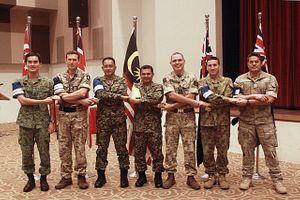Last week, Malaysia and Australia held the latest iteration of a new annualized defense consultation between them. The development highlighted some of the ongoing activity within the security aspect of the strategic partnership between the two countries amid wider domestic and foreign policy developments.
As I have observed before in these pages, Malaysia and Australia have a longstanding security relationship as part of their broader bilateral relationship that was elevated to a strategic partnership back in 2015. That aspect of ties, which in fact dates back prior to Malaysia’s official independence – with cooperation during World War II and the communist emergency – has been anchored under a mix of bilateral and multilateral arrangements, including the Malaysia-Australia Joint Defense Program and the Five Powers Defense Relationship (FPDA), which also includes New Zealand, Singapore, and the UK.
Both sides have been exploring ways to further develop defense ties over the past few years, which has been further catalyzed by the emergence of common challenges such as terrorism and violent extremism. A case in point was the agreement reached to convene an annual Australia-Malaysia High Level Committee, the first iteration of which was held last year in line with the 60th anniversary commemoration of Australia’s presence at the Royal Malaysian Air Force Butterworth Airbase.
Last week, the defense aspect of the relationship was in the spotlight again with the holding of the second iteration of the Australia-Malaysia High Level Committee. The meeting was held in Canberra, Australia, on September 25, and it was led by Australian Minister for Defense Linda Reynolds and Malaysia’s Defense Minister Mohamad Sabu.
As is usually the case in these interactions, during the meeting, the two defense ministers and their teams discussed the state of their defense relationship and exchanged views on defense and security challenges in the region and the world more generally. According to a joint statement on defense cooperation issued following the meeting, the issues discussed included counterterrorism and the return of foreign terrorist fighters and the role of various institutions including the Association of Southeast Asian Nations (ASEAN) and the FPDA.
The two countries also discussed more specific initiatives to build on their defense relationship. Perhaps most notable was the fact that the two countries agreed to establish a Defense Industry and Innovation Working Group under the Malaysia-Australia Joint Defense Program Dialogue framework, a signal of their willingness to increase collaboration on defense industry.
Apart from that, there were also commitments made for additional investment in the people-to-people engagement aspect of the defense relationship. As had been the case at the 2018 Australia-Malaysia High Level Committee, both sides agreed to increases in aspects of reciprocal exchanges between them, including the number of seconded personnel as well as fellowships and scholarships.
Unsurprisingly, few additional specifics were publicly disclosed about the private deliberations between the two sides. And to be sure, the High-Level Committee represents just one of several interactions between both countries. Nonetheless, these interactions will continue to be significant within the broader Australia-Malaysia security relationship as it develops in the coming months and years.

































